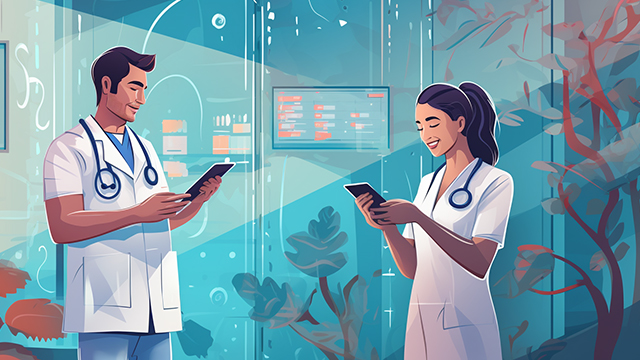Navigating Advances in Healthcare Wearables
Healthcare providers need your expertise to implement reliable systems that collect vital patient data.
BlueStar's diverse portfolio offers unparalleled access to premium products and services that drive business growth and success. From state-of-the-art hardware to advanced software solutions, our portfolio is designed to empower businesses with the tools they need to thrive in today's competitive landscape.
Our vertical-based content focuses on different industry technologies, solutions, and insights.
A true VAD offers top-notch pick, pack and ship services, and provides programs and services that add value to the distributed products that increase their value or worth.
The BlueStar Difference2 min read
BlueStar September 22, 2023 4:40:12 AM EDT

Information is vital to quality healthcare. The solutions you provide can keep the lines of communication open.
Healthcare teams need effective modes of communication to collaborate, coordinate care, minimize errors, and ensure the best possible outcomes. However, keeping the lines of communication open between practitioners and with the data and resources they need is a challenge in a fast-paced, dynamic healthcare setting. Healthcare communication solutions can overcome this hurdle. Innovations in healthcare communications give practitioners and their teams options for synchronizing their activity and enabling contact wherever they are.
Furthermore, healthcare’s digital transformation and need for effective communication are driving opportunities for technology solutions providers (TSPs) as the European healthcare IT market climbs upwards. According to Graphical Research, the market size exceeded USD 73 billion in 2021 and is expected to more than double, growing at a CAGR of 14 percent from 2022 to 2028.
TSPs’ Role in Healthcare Communications
Healthcare CIOs are seeking technologies and expertise to improve healthcare communications and, ultimately, the quality of care their organizations can provide. TSPs can provide their healthcare clients with effective solutions, including the following:
A mobile device is a familiar way to contact a healthcare practitioner. However, TSPs can make using mobile devices practical. First, multifunction devices, for example, those used for voice and text communication and barcode scanning, eliminate the need to carry more than one. Also, help your clients choose devices that are easy to carry, lightweight, comfortable, and ergonomic.
Also, remember that devices suited for use in healthcare settings should be constructed with materials that resist the growth of bacteria and can withstand cleaning with harsh sanitizers.
Traveling to a meeting room isn’t practical when a care team includes specialists or administrators that work in different facilities. Virtual visits and meetings save time, reduce expenses, facilitate collaboration and communication, and improve efficiency.
Continual voice calls or messages can disrupt practitioners’ workflows. Messaging is much more practical. Add value by implementing solutions that allow staff to prioritize messages when they send them so the recipient can immediately understand when the communication needs immediate attention and reduce alert fatigue.
Having AI field some communications may not seem contrary to keeping healthcare providers and staff connected. However, a virtual assistant may be able to answer simple questions, such as when a physician is available to meet, enabling collaboration while still allowing the doctor to focus on patient care without interruption.
Some communication is most effective when connecting the practitioner to patient data. mHealth, for example, provides up-to-the-minute data like blood pressure, blood sugar, and cardiac function and allows providers to quickly share data with the care team for seamless care.
Integrating the Healthcare Enterprise (IHE) is one initiative to coordinate adopting and using established standards in the healthcare space and enable computer systems to communicate better with each other. IHE helps providers, patients, and the industry share and use information more effectively. This increased interoperability aids in giving patients the best possible care.
Solutions that Capture Healthcare Providers’ Attention
TSPs that work in the healthcare space know that solutions that save time and decrease errors are the most likely to capture providers’ attention and inspire them to learn more.
The healthcare communication solutions you provide deliver those benefits and can also help create a positive employee culture, improve patient experiences, and contribute to better patient outcomes.
Use your tech and industry expertise to design optimal healthcare communication solutions to help your clients achieve those goals.

Healthcare providers need your expertise to implement reliable systems that collect vital patient data.

Take the opportunity to provide solutions that give healthcare organizations access to information and allow them to save time and enhance the...

Engaging patients and providing care digitally requires new technology. Meet the demand.